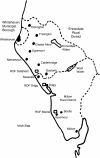Childhood leukaemia and ordnance factories in west Cumbria during the Second World War
- PMID: 16755299
- PMCID: PMC2360485
- DOI: 10.1038/sj.bjc.6603199
Childhood leukaemia and ordnance factories in west Cumbria during the Second World War
Abstract
Much evidence has accumulated that childhood leukaemia (CL) is a rare response to a common, but unidentified, infection and in particular that situations involving the unusual mixing of urban and rural groups (approximating to, respectively, groups infected with, and susceptible to, the relevant microorganism) can produce localised epidemics with consequent increases of the infrequent leukaemic complication. During the Second World War, explosives production factories were built and operated at Drigg and Sellafield, and a shell filling factory at Bootle, in west Cumbria, England, requiring substantial numbers of construction workers to be brought into this remote and isolated area. Following the design of an earlier study of CL near large (post-war) rural construction sites, mortality from this disease was investigated with the help of the Office of National Statistics, in the area around these Cumbrian factories where local workers largely lived, during the construction period and with particular reference to the overlapping construction and operational phase when the mixing of local and migrant workers would have been greatest. An excess of leukaemia deaths at ages 1-14 was found during the construction period (observed 3; observed/expected (O/E) 2.2, 95% confidence interval (CI): 0.6, 6.0), which was more marked and statistically significant during the overlap with operations (O 3; O/E 4.5, 95% CI: 1.1, 12.2), especially at ages 1-4 (O 2; O/E 7.1, CI: 1.2, 23.6). A previous investigation did not detect this excess because it considered only a small part of west Cumbria that omitted the communities where most of the workforce lived, having incorrectly attributed the post-war expansion of the village of Seascale (situated between Drigg and Sellafield) to the wartime ordnance factories. The present findings are consistent with the results of the earlier study of rural construction projects and with the general evidence that marked rural-urban population mixing increases the risk of CL.
Figures
References
-
- Anon (1941) Filling Factory Construction Programme. In: New Small Filling Factories Nos. 10/20. National Archives Catalogue Reference No. WO 185/18. Kew, UK: The National Archives
-
- Anon (1942a) Labour Requirements: Royal Ordnance Factories. National Archives Catalogue Reference No. AVIA 22/1161. Kew, UK: The National Archives
-
- Anon (1942b) Royal Ordnance Factory, Sellafield, Cumb. construction camp: proposed conversion to hostel for Royal Ordnance Factory workers. National Archives Catalogue Reference No. AVIA 22/1269. Kew, UK: The National Archives
-
- Anon (1945) R.O.F. Drigg/Sellafield/Bootle. Buildings and Rentals. In: Royal Ordnance Factory Sellafield, Cumb.: Disposal. National Archives Catalogue Reference No. AVIA 22/408. Kew, UK: The National Archives
-
- Anon (1946) The History of Royal Ordnance Factory Drigg National Archives Catalogue Reference No. SUPP 5/956. Kew, UK: The National Archives
Publication types
MeSH terms
Substances
LinkOut - more resources
Full Text Sources
Medical


